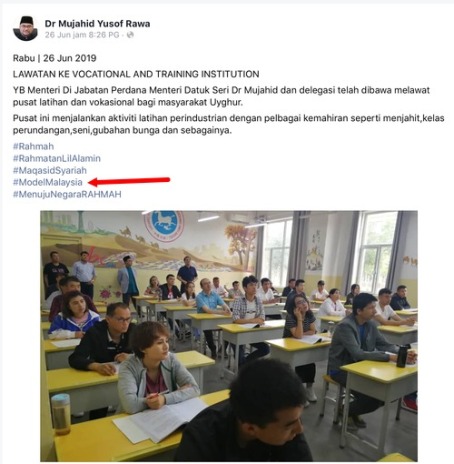Mujahid calls himself kanda and Nurul dinda. He is fake.

Mujahid Yusof , Religious Affairs Minister believes that the adult Uighurs being held by Beijing fiat in “vocational training centres” are being taught sewing, flower arrangement, the arts (patriotic songs and cultural dances), legal knowledge and other life enhancement skills.
It is shocking that Mujahid can say what he FB-ed about the purpose of those camps in his Kafkaesque Facebook statement.
Race and religion dynamics in Xinjiang
In the mid-18th century, China annexed the Uighur homeland of East Turkestan. The Chinese government now calls the territory ‘Xinjiang’ which in Mandarin means “new frontier”.
Landlocked Xinjiang borders Afghanistan, Kyrgyzstan, Tajikistan and Kazakhstan, among other countries. Uighurs form the majority of Xinjiang’s Turkic-speaking Muslims. The Kazakhs are the second biggest Muslim group in this so-called “autonomous” region under Beijing rule.
In 1949 (the year the modern People’s Republic of China was proclaimed), just 291,000 or 6.7 percent of Xinjiang’s population were Han Chinese.
As the result of a massive inflow of Chinese settlers, however, the Hans began to make up more than seven-and-a-quarter million or 40 percent of the population, according to the last available census from year 2000 – refer table above.
Spanning from early 19th century to today, the Uighurs have halved as a percentage (ethnic ratio) of the Xinjiang population after being overwhelmed by Chinese immigrants.
In the matter of religious expression, China is an equal opportunity repressor – be it of the Tibetan Buddhists, the evangelical Christians or Falun Gong new age spiritualists.
As one example of religious curbs, a 2017 Chinese law restricts the length to which Xinjiang’s Muslim men are allowed to grow their beard.
Overall, government surveillance and security measures in Xinjiang as well as thought policing are strict, former Uighur detainees interviewed by western media have claimed.
Ten years ago in July 2009, race riots broke out in Xinjiang’s capital city of Urumqi. The violence was mostly Uighurs killing Chinese.
Reprisal killings by Chinese of the Uighurs immediately followed. Uighur men and boys also suffered “enforced disappearances” in retaliation, said a Human Rights Watch report released three-and-a-half months after the Urumqi bloody riots.
Since then, programmes to Sinicize the Uighurs – that is, to make them less Muslim and more Chinese in behaviour – have intensified.


No comments:
Post a Comment